- Lakonia accommodation
- All Lakonia Accommodation
- Stay in Archaggelos
- Stay in Mavrovouni
- Accommodation in Greece
You need to upgrade your Flash Player
Please visit Adobe's Flash Player site to upgrade the most recent version.
Thank you.
If you are having issues with installing Adobe Flash Player, please make sure that all "pop-up killer" applications are turned off and you reinstall
the Adobe player.
Lakonia
Information about Lakonia
Vacation and accommodation in Greece is a complete Travel Guide for Greece. In Vacation-Greece you will find information on Greek islands and a list of hotels and villas in Peloponnese, studios and apartments for all budgets. Find hotel offers in Peloponnese, see maps and photos of Peloponnese, book flights, ferry tickets, discover Peloponnese, book guided tours and make hotel reservations.

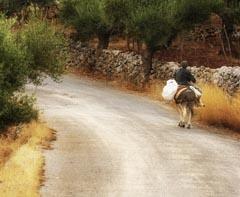 History
History
With the settling of the Dorians in the region (1100 BC), Sparta became the centre of the new colonists. New institutions and distinctions were created for the inhabitants.
Up till the time of Alexander Sparta and Athens were the most powerful city-states in Greece. In 146 BC, Sparta was subdued by the Romans. During the Byzantine era, Laconia was a province of the theme of the Peloponnese and suffered numerous attacks by barbarians.
In the 13th century, it fell to the Franks only to return in 1262 to the Byzantines who made their headquarters at Mistra. Two centuries later (1460) the Turks marched against Laconia and finally conquered the district in the mid 17th century.
The region of the Mani always retained some degree of autonomy and privilege. The area was liberated in 1828.
Laconian Mani
A barren land. Rocks, stone walls and prickly pears. Hard stones, naked hillsides. Bays and coves torn by the sea and the wind.
Men harder than the stones around them. Proud beings, these Maniots.
Every so often at the edge of the sea a small hamlet sprouts up. A series of mountain villages higher up. The towers of the Mani are well-known. Made of stone and fearless souls. You see one tower, then another and another.
Later heavy silence falls and you see Itillo before you. Deserted beaches for solitary roaming. Opposite stand the ruins of the fortress of Kelefa. Further on beneath a steep cliff lies the little harbour of Limeni.
High above looms Taigetos, its peaks forbidding and inaccessible. The haunt of the goddess Artemis.
Areopolis. Sharp rocks and white stones.- A harsh and remote landscape. It takes its name from Ares (Mars), god of war.
Honour and bravery. The courage of the Maniots is legendary. Ancestral glory. It echoes through the cobbled alleys of the city and in the corridors of the Kapetanaki Tower (a GNTO guest-house).
Pirgos Dirou. Towers everywhere. The most famous of all is the one belonging to the Sklavounakos family.
The Diros caves. Many-splendoured colours Stalactites and stalagmites form figures in a tight embrace. Awe and wonder
Then comes the tiny bay Mezapos, dotted with ruined towers. One looms above them all from its perch on a hich cliff, the ruined Castle of the Mani, Maina, which gave its name to the peninsula. Nothing here but stones, prickly pears and a few gnaried olive trees.
Gerolimenas. Some houses and a pier chockablock with caiques. Rest and relaxation in a friendly tavernaki. Calm and tranquillity.
To the north lie the towers of Kita and Nomia. To the south the village of Alika among the prickly pears. Further on the steep cape of Kiparissos. There was a temple to Poseidon here. The oracle and sanctuary of the Laconians and the temples of Demeter and Aphrodite.
Still further the little road to Marman and the cave of Hades. Where the descent to the Underworld began. This is the cavern Orpheus braved in his search fur the lost Eurydice.
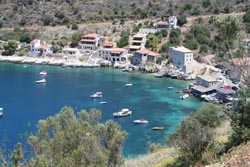 Beyond it lies Cape Tenaro or Matapas with its huge lighthouse followed by Porto Kagio, a refuge for quail and storks.
Beyond it lies Cape Tenaro or Matapas with its huge lighthouse followed by Porto Kagio, a refuge for quail and storks.
(You have to prowl about ceaselessly with the map to find these places or else take the more usual route, a ride around the peninsula by caique). You come to wheat fields and olive trees. Knolls crested with towers. Next the high hilltop of Vathia packed with grey towers. The towers of treasured tradition. Most of them have been restored and transformed into guest-houses by the GNTO. A refuge where peace and quiet reign.
In Mani the Cretan influence is pronounced. Many Maniots wear baggy breeches and head bandanas like the Cretans. With their decorated jackets and midriffs tightly swathed by heavy belts, tall and thin with thick moustaches and eyebrows, Ihey seem like heroes out of a fairy tale when you encounter them in the road or in a cafe. And Ihey have the same habits. They welcome you to their homes with a glass of the same fiery raki;, the same preserves and the same cup of coffee. They differ only in their songs and dances. Here the need for comfort from the pain of death gave birth to a unique form of folk poetry, the Maniot moirologia or laments. These are whoie poems that are sung al the grave.
They remind one of the lament of Andromache for Hector or the dirge of Hecuba for her lost children as well as of Byzantine threnodies.
Kotronas. Stone land and stone houses. A traditional village. Ringed by a warm bay.
Skoutari, Kalivia, Passavas, Githio (Sparta's port). Boats are tied up along its pier. The broadest of beaches. Houses, shops, tavernas.
Opposite it lies Marathonisi, no longer an island. Tradition maintains that this is where Paris spent the night with the lovely Helen. The Tzanetakis lower stands in the centre of the island. To the north, on a hill, lie the ruins oi the ancient acropolis. Githio has a small collection of archaeological and Byzantine artefacts on view in the Town Hall.
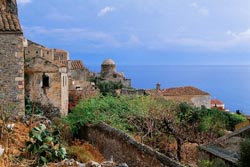 Central Laconia
Central Laconia
Sparta (Sparti) is the capital of the prefecture. A simple town, built It in the middle of the Evrotas nvef valley, in the same site where the ancient cily stood. Some ruins remain of the ancient acropolis, the sanctuary of Artemis Orthia (6th c. BC), the tomb of Leonidas (5th c. BC) and the Menelaion. The museum with finds from the area is housed in a neoclassical building in the centre of town. The plain of Laconia spreads out around Sparta, green and cool. A few kilometres distant is the ascent for Taigetos. Snowy peaks and precipitious rocks. Plateaus and ravines Olive groves on the gentler slopes. Poplars, willows and plane trees line the banks of the Evrotas. Gardens of every shade of green.
And the series of villages continues. Some drenched in chestnut trees (Anavrito) or enormous plane trees (Karies) or perched in precarious sports — real eagles' nests (Georgitsi). Some boasting castles and Byzantine churches (Geraki, Vresthena, Vrondamas) and others simply bucolic.
The succession of villages makes you want to wander and poke about them.
Every instant is different. You need love and an adventurous spirit to walk this land. But who would not love it?
The Byzantine state of Mistras
As you approach Mistras (6 km from Sparta) you feel as though you're making a pilgrimage to Byzantine Greece. Going up the hill, you enter through the castle gate, which welcomes you to wander for a while, delighted, through the narrow lanes of this once invincible fortress.
The castle of Mistras was built by the Franks in 1249 in their attempt to establish their supremacy over the Peloponnese.
Their catastrophic defeat at Pelagonia (1259) forced them to hand over Mistra to the Greeks. The Frankish prince Guillaume de Villehardouin erected the castle. He built bastions for his knights, houses, dungeons, storerooms, courtyards. From up here he ruled over the world of the Evrotas. As time went by, houses were built on the hillside under the Frankish caslte, and a town was born whose late was to become the centre of civilisation and the cradle of the last dynasty of the Byzantine emperors.
The houses roundabout are of two or three storeys. With their imposing vaulted roofs and arcades these mansions lead up to the Palace, an architectural creation of the Palaiologues. The throne room, the chapel with its vestiges of Byzantine frescoes, the rooms lighted by large windows with ogival arches, are some of the features of this building whose construction took place in various periods, according to the style prevalling in Constantinople. During Its two centuries of Mistras' existence as the Byzantine capital of the Peloponnese many churches and monasteries with domes and chapels were erected, representing all the painting trends of the capital.
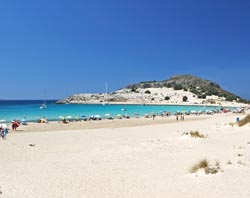 The most important monument you meet on your way up - and the first to be built - is the Cathedral of Agios Dimitrios. On the floor of the church is the two-headed eagle, symbol of the Palaiologos dynasty, carved into a plaque. According to tradition, this is where Konstantinos stepped when he was crowned King. Next to it stands the carved throne.
The most important monument you meet on your way up - and the first to be built - is the Cathedral of Agios Dimitrios. On the floor of the church is the two-headed eagle, symbol of the Palaiologos dynasty, carved into a plaque. According to tradition, this is where Konstantinos stepped when he was crowned King. Next to it stands the carved throne.
In 1449, Konstantinos Palaiologos was crowned emperor of Byzantium and he left Mistras for Constantinople. In 1453 the Turks captured Constantinople, and a few years later, in 1460, the same fate befell Mistras.
Mistras, the brilliant capital of the Despotate of the Morea, was reduced to an insignificant village.
The frescoes in the Cathedral show a shining sky painted by skilfull hands. One wing of the church houses the Museum.
Towards the northern corner of the enclosure stand Mistras' two most impressive churches, Agii Theodori and the Panagia Odigitria, known as the Afentiko. Its wall paintings hold you spellbound.
Near the highest gate of the castle stands the church of Agia Sofia, while on the slope to the east is the Pantanassa monastery, built by the lords of the 15th century. The church is impressive in its elegance and refinement. Its frescoes are filled with bright colour and movement The Pantanassa today is a hospitable convent with clean cells looked after by gentle nuns, the only living beings in Mistras. Strolling through the narrow lanes of the dead city, you finally come to the Perinlepto, the monastery built under a rock with marvellous frescoes. It is from here that the ascent to the castle begins. Winding stairways, arcades, coutyards. Everything in ruins: crumbling facades, turrets with ravaged opening, damaged plaques, decayed mansions. At some point you reach the bare part of the mountain. Below you stretches the endless valley.
In front of you a steep path leads to the top of the hill. In an impregnable position, its ramparts and fortification impose themselves on the landscape. The security this castle offered in the face of foreign and local enemies permitted its bishops, lords, enlightened clerics, founders of schools of philosophy, monks, artists, writers and other men of intellect, like Pachomius, Nikephoros Moschopoulos and Gemistos Plethon to transform this town "protected by God", into a cradle of the Renaissance.
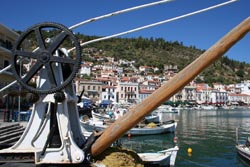 Southeastern Laconia
Southeastern Laconia
The farthest finger of the Peloponnese. The Laconic gulf on the west, the Mirtoo sea on the east. Along both coasts and at some distance from the sea there are scattered villages One beach after another and then another even larger.
Everything baked by the sun and basted by the sea. On the southern coast of the peninsula, looking onto the Mirtoo sea, stands the former Byzantine-Venetian fortress-state of Monemvassia. on its rocky promontory. From afar it looks as if it could be an island. In Greek Monemvassia means one entrance the long causeway joining it to the mainland was and is the only access to the rock.
Time slopped here in the Middle Ages. Castles and ramparts, old mansions, little houses, narrow lanes paved with stone slabs, churches with crumbling facades, old low archways, semi-destroyed stairways.
Every little detail calls up memories of Byzantium and the Venetians.
Apses, escutcheons, imperial marble thrones, Byzantine icons (Christ in chains) give one the impression of an imaginary city, untouched by modern times. This delight in the past overcomes you and conjures up visions of princes and emperors, knights and bishops. For Monemvassia is a revelation that leaves one with a heavy heart and a deep nostalgia, a feeling that one would like to stay here forever.
North of Monemvassia the region of Zaraka is full of medieval villages, built high in the mountains alongside ruined castles, churches and houses, with names like Harakas, Rihia, Gerakas, Ag. Olmltrls, Glotsoli and Kiparissi. Sixty-one kilometres from Monemvassia across the peninsula lies the seaside market town of Neapolis, the last port of the Spartans on the Laconic gulf. Beaches, bays, springs, plane and walnut trees (Paradisi), caves lined with stones that look like coloured woven fabrics (Kastania), tavernas, cafes, people with warm smiles - it would be easy to surrender to a life of nothing but this.
Opposite Neapolis is the islet of Elafonissi, a dream snatched from the South Seas.
Swimming, fishing, sand, sun, twilight, moonlight, octopus in red wine, fish stew and seafood are the way of life here.
On the horizon beyond lies Kilhira, the isle of Eros, the legendary birthplace of the goddess Aphrodite (Venus). From the moment that you penetrate into the interior of the island you will discover ancient temples, Byzantine churches and monasteries, Venetian castles, caves with stalactites and stalagmites and miniature lakes, villages with the distinctive architecture of the Ionian islands, pebbly beaches, sandy beaches, multicoloured shells, greenery, hills and countless birds. All giving the feelling of a world where happiness and the joy of life reign supreme.
The caique stops its engine at Antikilhira, a barren rock in the middle of the sea. The island is famous because of its shores the wonderful statue of the Ephebos ol Antikithira was found.
Here you will spend your days and nights in the embrace of the sea, in company with the sun and the moon and the sea breeze. Maybe one day a modern-day Aphrodite will rise from the seafoam.

 History
History
With the settling of the Dorians in the region (1100 BC), Sparta became the centre of the new colonists. New institutions and distinctions were created for the inhabitants.
Up till the time of Alexander Sparta and Athens were the most powerful city-states in Greece. In 146 BC, Sparta was subdued by the Romans. During the Byzantine era, Laconia was a province of the theme of the Peloponnese and suffered numerous attacks by barbarians.
In the 13th century, it fell to the Franks only to return in 1262 to the Byzantines who made their headquarters at Mistra. Two centuries later (1460) the Turks marched against Laconia and finally conquered the district in the mid 17th century.
The region of the Mani always retained some degree of autonomy and privilege. The area was liberated in 1828.
Laconian Mani
A barren land. Rocks, stone walls and prickly pears. Hard stones, naked hillsides. Bays and coves torn by the sea and the wind.
Men harder than the stones around them. Proud beings, these Maniots.
Every so often at the edge of the sea a small hamlet sprouts up. A series of mountain villages higher up. The towers of the Mani are well-known. Made of stone and fearless souls. You see one tower, then another and another.
Later heavy silence falls and you see Itillo before you. Deserted beaches for solitary roaming. Opposite stand the ruins of the fortress of Kelefa. Further on beneath a steep cliff lies the little harbour of Limeni.
High above looms Taigetos, its peaks forbidding and inaccessible. The haunt of the goddess Artemis.
Areopolis. Sharp rocks and white stones.- A harsh and remote landscape. It takes its name from Ares (Mars), god of war.
Honour and bravery. The courage of the Maniots is legendary. Ancestral glory. It echoes through the cobbled alleys of the city and in the corridors of the Kapetanaki Tower (a GNTO guest-house).
Pirgos Dirou. Towers everywhere. The most famous of all is the one belonging to the Sklavounakos family.
The Diros caves. Many-splendoured colours Stalactites and stalagmites form figures in a tight embrace. Awe and wonder
Then comes the tiny bay Mezapos, dotted with ruined towers. One looms above them all from its perch on a hich cliff, the ruined Castle of the Mani, Maina, which gave its name to the peninsula. Nothing here but stones, prickly pears and a few gnaried olive trees.
Gerolimenas. Some houses and a pier chockablock with caiques. Rest and relaxation in a friendly tavernaki. Calm and tranquillity.
To the north lie the towers of Kita and Nomia. To the south the village of Alika among the prickly pears. Further on the steep cape of Kiparissos. There was a temple to Poseidon here. The oracle and sanctuary of the Laconians and the temples of Demeter and Aphrodite.
Still further the little road to Marman and the cave of Hades. Where the descent to the Underworld began. This is the cavern Orpheus braved in his search fur the lost Eurydice.
 Beyond it lies Cape Tenaro or Matapas with its huge lighthouse followed by Porto Kagio, a refuge for quail and storks.
Beyond it lies Cape Tenaro or Matapas with its huge lighthouse followed by Porto Kagio, a refuge for quail and storks.
(You have to prowl about ceaselessly with the map to find these places or else take the more usual route, a ride around the peninsula by caique). You come to wheat fields and olive trees. Knolls crested with towers. Next the high hilltop of Vathia packed with grey towers. The towers of treasured tradition. Most of them have been restored and transformed into guest-houses by the GNTO. A refuge where peace and quiet reign.
In Mani the Cretan influence is pronounced. Many Maniots wear baggy breeches and head bandanas like the Cretans. With their decorated jackets and midriffs tightly swathed by heavy belts, tall and thin with thick moustaches and eyebrows, Ihey seem like heroes out of a fairy tale when you encounter them in the road or in a cafe. And Ihey have the same habits. They welcome you to their homes with a glass of the same fiery raki;, the same preserves and the same cup of coffee. They differ only in their songs and dances. Here the need for comfort from the pain of death gave birth to a unique form of folk poetry, the Maniot moirologia or laments. These are whoie poems that are sung al the grave.
They remind one of the lament of Andromache for Hector or the dirge of Hecuba for her lost children as well as of Byzantine threnodies.
Kotronas. Stone land and stone houses. A traditional village. Ringed by a warm bay.
Skoutari, Kalivia, Passavas, Githio (Sparta's port). Boats are tied up along its pier. The broadest of beaches. Houses, shops, tavernas.
Opposite it lies Marathonisi, no longer an island. Tradition maintains that this is where Paris spent the night with the lovely Helen. The Tzanetakis lower stands in the centre of the island. To the north, on a hill, lie the ruins oi the ancient acropolis. Githio has a small collection of archaeological and Byzantine artefacts on view in the Town Hall.
 Central Laconia
Central Laconia
Sparta (Sparti) is the capital of the prefecture. A simple town, built It in the middle of the Evrotas nvef valley, in the same site where the ancient cily stood. Some ruins remain of the ancient acropolis, the sanctuary of Artemis Orthia (6th c. BC), the tomb of Leonidas (5th c. BC) and the Menelaion. The museum with finds from the area is housed in a neoclassical building in the centre of town. The plain of Laconia spreads out around Sparta, green and cool. A few kilometres distant is the ascent for Taigetos. Snowy peaks and precipitious rocks. Plateaus and ravines Olive groves on the gentler slopes. Poplars, willows and plane trees line the banks of the Evrotas. Gardens of every shade of green.
And the series of villages continues. Some drenched in chestnut trees (Anavrito) or enormous plane trees (Karies) or perched in precarious sports — real eagles' nests (Georgitsi). Some boasting castles and Byzantine churches (Geraki, Vresthena, Vrondamas) and others simply bucolic.
The succession of villages makes you want to wander and poke about them.
Every instant is different. You need love and an adventurous spirit to walk this land. But who would not love it?
The Byzantine state of Mistras
As you approach Mistras (6 km from Sparta) you feel as though you're making a pilgrimage to Byzantine Greece. Going up the hill, you enter through the castle gate, which welcomes you to wander for a while, delighted, through the narrow lanes of this once invincible fortress.
The castle of Mistras was built by the Franks in 1249 in their attempt to establish their supremacy over the Peloponnese.
Their catastrophic defeat at Pelagonia (1259) forced them to hand over Mistra to the Greeks. The Frankish prince Guillaume de Villehardouin erected the castle. He built bastions for his knights, houses, dungeons, storerooms, courtyards. From up here he ruled over the world of the Evrotas. As time went by, houses were built on the hillside under the Frankish caslte, and a town was born whose late was to become the centre of civilisation and the cradle of the last dynasty of the Byzantine emperors.
The houses roundabout are of two or three storeys. With their imposing vaulted roofs and arcades these mansions lead up to the Palace, an architectural creation of the Palaiologues. The throne room, the chapel with its vestiges of Byzantine frescoes, the rooms lighted by large windows with ogival arches, are some of the features of this building whose construction took place in various periods, according to the style prevalling in Constantinople. During Its two centuries of Mistras' existence as the Byzantine capital of the Peloponnese many churches and monasteries with domes and chapels were erected, representing all the painting trends of the capital.
 The most important monument you meet on your way up - and the first to be built - is the Cathedral of Agios Dimitrios. On the floor of the church is the two-headed eagle, symbol of the Palaiologos dynasty, carved into a plaque. According to tradition, this is where Konstantinos stepped when he was crowned King. Next to it stands the carved throne.
The most important monument you meet on your way up - and the first to be built - is the Cathedral of Agios Dimitrios. On the floor of the church is the two-headed eagle, symbol of the Palaiologos dynasty, carved into a plaque. According to tradition, this is where Konstantinos stepped when he was crowned King. Next to it stands the carved throne.
In 1449, Konstantinos Palaiologos was crowned emperor of Byzantium and he left Mistras for Constantinople. In 1453 the Turks captured Constantinople, and a few years later, in 1460, the same fate befell Mistras.
Mistras, the brilliant capital of the Despotate of the Morea, was reduced to an insignificant village.
The frescoes in the Cathedral show a shining sky painted by skilfull hands. One wing of the church houses the Museum.
Towards the northern corner of the enclosure stand Mistras' two most impressive churches, Agii Theodori and the Panagia Odigitria, known as the Afentiko. Its wall paintings hold you spellbound.
Near the highest gate of the castle stands the church of Agia Sofia, while on the slope to the east is the Pantanassa monastery, built by the lords of the 15th century. The church is impressive in its elegance and refinement. Its frescoes are filled with bright colour and movement The Pantanassa today is a hospitable convent with clean cells looked after by gentle nuns, the only living beings in Mistras. Strolling through the narrow lanes of the dead city, you finally come to the Perinlepto, the monastery built under a rock with marvellous frescoes. It is from here that the ascent to the castle begins. Winding stairways, arcades, coutyards. Everything in ruins: crumbling facades, turrets with ravaged opening, damaged plaques, decayed mansions. At some point you reach the bare part of the mountain. Below you stretches the endless valley.
In front of you a steep path leads to the top of the hill. In an impregnable position, its ramparts and fortification impose themselves on the landscape. The security this castle offered in the face of foreign and local enemies permitted its bishops, lords, enlightened clerics, founders of schools of philosophy, monks, artists, writers and other men of intellect, like Pachomius, Nikephoros Moschopoulos and Gemistos Plethon to transform this town "protected by God", into a cradle of the Renaissance.
 Southeastern Laconia
Southeastern Laconia
The farthest finger of the Peloponnese. The Laconic gulf on the west, the Mirtoo sea on the east. Along both coasts and at some distance from the sea there are scattered villages One beach after another and then another even larger.
Everything baked by the sun and basted by the sea. On the southern coast of the peninsula, looking onto the Mirtoo sea, stands the former Byzantine-Venetian fortress-state of Monemvassia. on its rocky promontory. From afar it looks as if it could be an island. In Greek Monemvassia means one entrance the long causeway joining it to the mainland was and is the only access to the rock.
Time slopped here in the Middle Ages. Castles and ramparts, old mansions, little houses, narrow lanes paved with stone slabs, churches with crumbling facades, old low archways, semi-destroyed stairways.
Every little detail calls up memories of Byzantium and the Venetians.
Apses, escutcheons, imperial marble thrones, Byzantine icons (Christ in chains) give one the impression of an imaginary city, untouched by modern times. This delight in the past overcomes you and conjures up visions of princes and emperors, knights and bishops. For Monemvassia is a revelation that leaves one with a heavy heart and a deep nostalgia, a feeling that one would like to stay here forever.
North of Monemvassia the region of Zaraka is full of medieval villages, built high in the mountains alongside ruined castles, churches and houses, with names like Harakas, Rihia, Gerakas, Ag. Olmltrls, Glotsoli and Kiparissi. Sixty-one kilometres from Monemvassia across the peninsula lies the seaside market town of Neapolis, the last port of the Spartans on the Laconic gulf. Beaches, bays, springs, plane and walnut trees (Paradisi), caves lined with stones that look like coloured woven fabrics (Kastania), tavernas, cafes, people with warm smiles - it would be easy to surrender to a life of nothing but this.
Opposite Neapolis is the islet of Elafonissi, a dream snatched from the South Seas.
Swimming, fishing, sand, sun, twilight, moonlight, octopus in red wine, fish stew and seafood are the way of life here.
On the horizon beyond lies Kilhira, the isle of Eros, the legendary birthplace of the goddess Aphrodite (Venus). From the moment that you penetrate into the interior of the island you will discover ancient temples, Byzantine churches and monasteries, Venetian castles, caves with stalactites and stalagmites and miniature lakes, villages with the distinctive architecture of the Ionian islands, pebbly beaches, sandy beaches, multicoloured shells, greenery, hills and countless birds. All giving the feelling of a world where happiness and the joy of life reign supreme.
The caique stops its engine at Antikilhira, a barren rock in the middle of the sea. The island is famous because of its shores the wonderful statue of the Ephebos ol Antikithira was found.
Here you will spend your days and nights in the embrace of the sea, in company with the sun and the moon and the sea breeze. Maybe one day a modern-day Aphrodite will rise from the seafoam.

